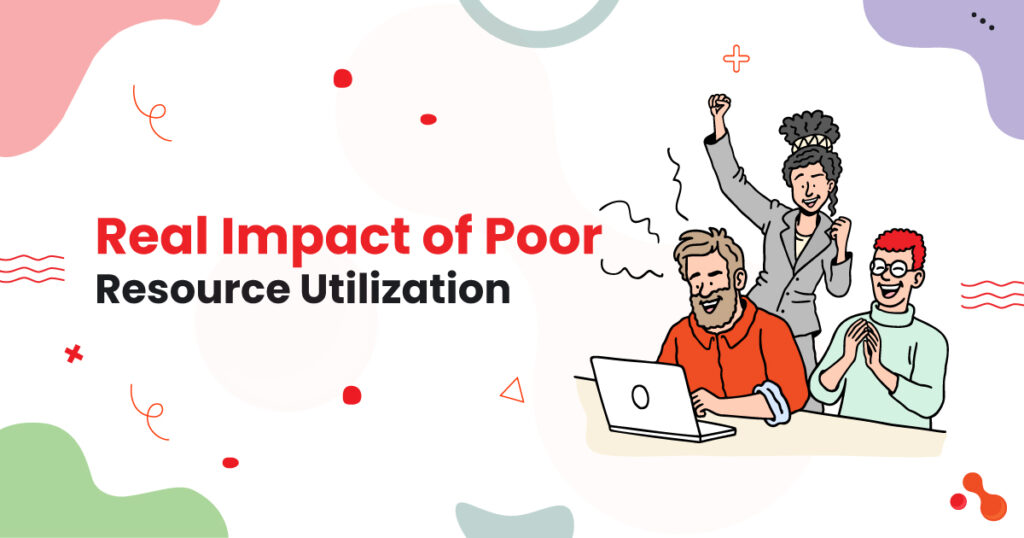Introduction
The real impact of poor resource utilization on software project success is multifaceted and profound. It influences various dimensions of a project, including its timeline, budget, quality, and overall success.
To understand its impact, it’s crucial to first understand that resources in a software project encompass not just the financial allocations but also the human capital, technological assets, time, and information.
Inadequate utilization of any of these resources can derail a project, leading to failed objectives, dissatisfied stakeholders, and financial losses. In the dynamic landscape of software development, resource utilization plays a pivotal role in determining the success or failure of a project.
Poor resource management can have far-reaching consequences that reverberate throughout the entire development lifecycle.
This article delves into the tangible impacts of inadequate resource utilization on software project success.
What Is Resource Utilization in Software Projects?

Resource utilization refers to how effectively an organization uses its resources to achieve project goals. In software projects, this means deploying personnel, technology, information, and budget in ways that maximize productivity and value creation while minimizing waste and inefficiencies.
One of the primary consequences of inadequate resource utilization is the escalation of project costs. This can result in budget overruns and financial strain on the organization.
Impact of Poor Resource Utilization

Optimal resource usage requires one to monitor the project proactively. A failure to do so often means the resources are wasted and the firm is also adversely affected.
One has to face far reaching consequences for mismanaging the resources, which includes financial as well as the overall operations.
Here is the impact of ill-utilization of resources:
Financial Consequences:.
Poor utilization of resources directly impacts a project’s economic health. Overstaffing, underutilization of skilled personnel, inefficient use of technologies, and misallocation of budget can inflate project costs unnecessarily. Conversely, understaffing or allocating insufficient budget segments can lead to corners being cut, resulting in subpar outcomes that may require costly rework.
Time Delays:
In software development, time is a critical resource. Inefficient utilization of resources often leads to bottlenecks, where the progress of one team or phase is stalled waiting for another to complete its tasks. This can cascade through the project timeline, causing delays that not only postpone the delivery but can also lead to missed market opportunities and, consequently, lost revenue.
Impact on Quality:
The quality of the software product is directly tied to how resources are utilized. For instance, if multiple tasks spread skilled developers too thin, the attention and effort they can dedicate to each diminish, potentially leading to bugs, security vulnerabilities. Similarly, inadequate investment in quality assurance resources can lead to a flawed product that tarnishes the company’s reputation and incurs additional post-launch support costs.
Team Morale and Productivity:
The human aspect of resource utilization cannot be overstated. Poor allocation of tasks that don’t consider team member’s skills or interests can lead to disengagement, low morale, and high turnover.
Stakeholder Satisfaction:
Stakeholders, whether they are investors, clients, or end-users, have expectations regarding the delivery timeline, budget, and quality of the software product. Poor utilization of resources can lead to unmet expectations in these areas, resulting in dissatisfaction and, in the worst cases, loss of future business or investment.
Missed Innovation Opportunities:
In software development, innovation often stems from a well-balanced and motivated team. Poor resource management stifles the creative process, leaving team members with little time or energy for strategic thinking and innovation.
Minor issues add up:
Poor implementation of the resources tends to cause a rise in the minor issues in the project. These services of small problems add up and affect the budget.
Performance takes a hit:
The overall performance of the organization will deteriorate in the case of poor usage of resources. The departments are blindsided by the availability of resources. This affects the outcome of the project because of under-equipping and understaffing of the teams. It leads to a false increase in the work pressure, unrealistic deadlines and increases the chances of bugs and errors.
A very fitting quote:
“Software development is both challenging and rewarding. It’s creative like an art form, but (unlike art) it provides concrete, measurable value” – Chad Fowler
Example Of Poor Resource Utilization
An excellent example of how poor utilization of resources affects your software is explained here. Consider a software project as the development of a mobile application for a startup company.
In this scenario, the project team consisted of a mix of developers, designers, and testers.
Overloaded Developers:
Some developers were assigned multiple tasks simultaneously, leading to burnout and decreased productivity. As a result, they struggled to meet deadlines and produce high-quality code.
Underutilized Designers:
The designers, on the other hand, were underutilized, with limited tasks assigned to them. The design team experienced frustration and demotivation due to feeling underutilized as their skills were not being fully leveraged.
Inefficient Testing:
The testing phase was rushed due to delays in development. Testers had limited time to thoroughly test the application, which resulted in them overlooking several bugs and issues. This led to a poor user experience and negative feedback from users.
Budget Overruns:
The project incurred unexpected costs due to the need for additional resources to compensate for poor resource utilization. Overtime expenses and the need to hire additional developers to meet deadlines contributed to budget overruns.
Missed Deadlines:
Ultimately, the project experienced delays in delivery, missing the initial launch deadline. This had a significant impact on the company’s plans and market positioning, as competitors launched similar applications ahead of schedule.
In this example, poor resource utilization resulted in decreased productivity, compromised quality, budget overruns, and missed deadlines. It highlights the importance of effective resource planning, allocation, and communication in software projects to ensure success.
Hire Remote Developers

Adopt a strategic approach to enhance resource utilization. Effective resource utilization starts with meticulous planning, where project requirements are carefully analyzed and resources are allocated optimally across the project timeline. Technologies can offer significant advantages in monitoring and optimizing resource utilization.
Investing in continuous learning and development ensures that the team’s skills are up-to-date and aligned with project needs. Foster a culture of open communication and collaboration across different teams and stakeholders.
At Acquaint Softtech, we implement all this and more. We are a software outsourcing company in India with over 10 years of experience. Our highly skilled developers have successfully delivered over 5000 projects. Our ability to manage the resources and prevent budget overruns has played a good part in our success.
Hire remote developers from Acquaint Softtech to gain the upper edge. We believe in making high-quality solutions available to everyone. We also have exposure to a wide range of industries and extensive experience developing cutting-edge solutions.
Hence outsourcing to Acquaint Softtech is a smart business decision. An excellent example of success with outsourcing is the tech giant Google. They are one of the most successful companies, and they, too, believe in taking advantage of outsourcing.
Conclusion
The impact of poor resource utilization on software project success is significant and multi-layered. It affects the financial bottom line, project timeline, product quality, team morale, and stakeholder satisfaction.
Addressing this issue requires a strategic approach that encompasses thorough planning, leveraging technology, investing in skills development, and fostering a collaborative work environment. By prioritizing efficient resource utilization, organizations can enhance their project success rates, deliver superior software products, and maintain competitive advantages in the rapidly evolving technology landscape.
FAQ
What is resource utilization in the context of project management?
Resource utilization refers to the effective allocation and management of resources, including human resources, equipment, time, and budget, to achieve project objectives efficiently.
How does poor resource utilization affect project success?
Poor resource utilization can lead to a variety of negative impacts on project success, including delays in project timelines, increased development costs, compromised code quality, decreased team morale and productivity, client dissatisfaction, and missed opportunities for innovation.
What are some examples of poor resource utilization in software projects?
Examples of poor resource utilization in software projects include overloading team members with too many tasks, underutilizing skilled resources, inadequate planning and scheduling of resources, inefficient use of project budgets, and failure to adapt resource allocations to changing project requirements.
How can poor resource utilization be mitigated in software projects?
Comprehensive resource planning, adoption of agile methodologies for flexibility, transparent communication with the project team, utilization of project management tools for tracking and managing resources, and continuous monitoring and adjustment of resource allocations based on project needs can mitigate poor resource utilization.
What are the long-term consequences of poor resource utilization on project success?
The long-term consequences of poor resource utilization on project success may include reputational damage to the project team or organization, decreased client satisfaction leading to loss of future business opportunities, reduced team morale and retention rates, and diminished ability to innovate and compete in the marketplace.


